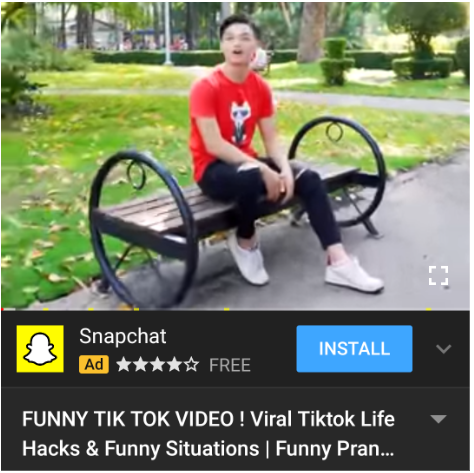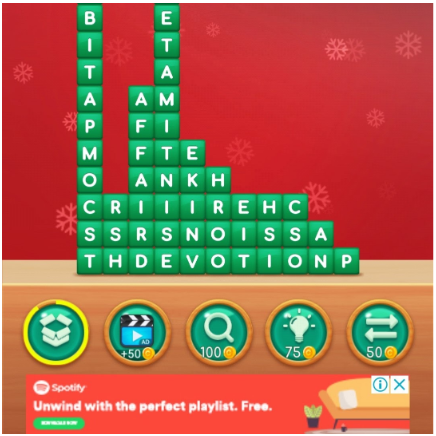Table of Content
The tremendous growth in mobile phone usage, especially with an increase in tech-savvy mobile app, has made the app marketplace a fantastic arena to showcase your products and services. The app marketplace, however, is extremely competitive. With millions of apps to choose from, and thousands being uploaded daily, finding your spot matters a lot.
To excel in such a crowd, you need more than a well-designed and intriguing app to gain the downloads you deserve. For that, an effective marketing strategy must be executed – one that reaches the right person, at the right time.
While there are several ways to market your app to increase downloads and topping the hit charts, like social media and influential marketing campaigns, one of the best ways is via app install ads.
 Image Credit: mobilemarketingreads.com
Image Credit: mobilemarketingreads.com
What is an app install ad?
They are the ads we see inside an app, persuading us to install another app. App install ads are clean and seamless. They fit right into the host environment, prompting the users to try them out. These ads are one of the best marketing strategies to drive installs. Let’s look at some of the best real-world examples of app install ads and demystify why they work so well.
1. Bumble (in Facebook)
Facebook was one of the first to incorporate in app advertising. Here, Bumble’s app install ads look and feel just like another Facebook post. It is seamless enough to blend into a typical post setting, but the usage of an eye-catchy image makes all the difference.
Bumble also shined in including the number of your Facebook friends using the app, and urging you to try it.
Key Takeaways:
- The caption does a great job in influencing the users to install the app with peer pressure, using the “Everybody’s doing it” phrase.
- The ad naturally blends with other posts, making the advertising very subtle.
- The post beautifully incorporates the brand’s colour theme to create a convincing image.
- The Call-to-action or CTA is precise and straightforward.
- Showing the number of friends using the app adds one more reason to try the app.
2. Klondike Adventures (in Gaana)
Gaana, being an online music player, undergoes frequent app opening and closing in a day, and Klondike Adventures app install ads utilise this unique opportunity to the best. Whenever a user tries to quit the app or change tracks, an ad pops up, which blends into the host’s interface.
The most exciting part – the Klondike Adventures app install ads come with live gameplay, along with a “Try it yourself!” and the CTA “Play Game”. For a person spending their leisure time listening to music, this ad would likely prompt the user to try it out.
Key Takeaways:
- Real gameplay makes the ad approachable.
- Ads blend into the host’s UI.
- The copy “Try it yourself!” is intriguing.
- “Play Game” CTA is concise and prompting.
3. HAGO (in TikTok)
One of the strategies HAGO nailed is placing their app install ads in front of the right audience. With TikTok being extensively used by teenagers who have all the time in the world, an app that involves playing multiplayer games with online friends is a great way to have fun.
Another overwhelming emotion the ad plays with is with the copy “Someone asks to add you as a friend, Accept?”, inciting the urge to find out more. The text is followed by a CTA, which seems natural.
Key Takeaways:
- Live gameplay with pictures of two players increases the credibility.
- A copy that excites us to find out more.
- Subtle placement of CTA.
- Placing the app install ads in the right medium.
4. Snapchat (in YouTube)
A “godly” level marketing strategy is one which involves transcending your competitors’ marketing plans by using their keywords and converting their potential leads to yours. With these YouTube app install ads, Snapchat once again proves it’s always ahead of the game.
An impressive characteristic of the ad is the inclusion of the word “FREE”, adding one more reason to try out the app without any hassle. The CTA button is clear and present throughout the video.
Key Takeaways:
- Utilises competitors’ keywords to market its product.
- The word “FREE” can make a big difference.
- A solid CTA button, throughout the video.
- Choosing the right platform to promote an app can induce higher downloads.
5. Spotify (in Word Swipe)
The Word Swipe game places app install ads as a clickable banner that redirects to the play store. Even though this strategy is extensively used in many other apps, what works well here is the placement of the banner. It is placed at the bottom, near the game’s frequently used options. By doing so, there is a higher chance for the users to notice the ad and take action.
This app install ad is minimalistic but with a moving ad copy. Spotify presents itself to be an app for “unwinding”, prompting viewers to give it a try.
Key Takeaways:
- App install ads are thoughtfully placed.
- Minimalistic images with emotive ad copies.
- Ad colour theme blends in with the host app.
6. Headspace (in Instagram)
Many of us are busy and disconcerted in one way or another. The Headspace app uses this fragility of ours as their unique selling point. The copy is concise and to the point – “Treat your head right”. The app further promises mindfulness within 10 minutes a day. Anyone seeking a peace of mind would click the install button.
The Headspace app install ads have much to offer. Within the image, they address two other concerns – stress and sleep. That is a great way to let potential users know what the app is all about. Further, the image of a woman relaxing and seizing the moment is an ideal illustration of what all of us desire to achieve.
Key Takeaways:
- The in app advertising utilises contemporary colour palettes for the image.
- The ad copy is precise and engaging.
- The ad addresses our modern-day life stresses.
- The image aligns with the ad copy – Treating your head right.
7. Amazon Music (in 30 Day Fitness Challenge)
What is the best way to make workouts more interesting? The answer is good music, always. The Amazon Music app uses this very concept to introduce itself and target potential users through the workout app 30 Day Fitness Challenge. In this case, the Amazon Music app install ads are perfectly placed, as every workout needs good music.
Another aspect of this ad that ensures a high number of downloads is the use of the term “ad-free”. As the majority of online music players are interrupted with frequent ads, Amazon Music promises an uninterrupted music experience.
Key Takeaways:
- The ad meets the immediate need of the user.
- The term “ad-free” can gather immense interest.
- The CTA is well-defined and stands out.
- The app install ad doesn’t meddle with the host app’s usage.
8. YouTube Music (in YouTube)
Introduced a few years ago, YouTube Music took some time to gain traction. The music app solves a critical issue of YouTube – to continue playing music even after the user exits the app. With a high number of users relying on YouTube for, it is logical to place the YouTube Music app install ads in YouTube itself.
The in app advertising doesn’t meddle with the YouTube user experience. It is placed between video feeds and blends right into the interface. At first glance, the YouTube Music app looks like an extension to the YouTube app.
Key Takeaways:
- Both apps are similar in character; there is a higher chance for users to install it.
- The in app advertising blends into the host app.
- App ads cause minimal hindrance to the user experience.
- Clear CTA button – “Get the App”.
9. Gardenscapes (in Wallcraft)
The Wallcraft app provides stunning wallpapers and does a fairly impressive job in app install ads placement. The Gardenscapes game app ad fits right into the app’s layout. While scrolling through wallpapers, the app installs ads do not interfere with the interface.
The Gardenscapes app install ad uses the text “Make sure you’re up to the challenge” to provoke a challenge mindset. The illustration used inspires eagerness to know how the game works. Along with that, the image carries statistics on how many players can save him. This is followed by a clear CTA as well.
Key Takeaways:
- Challenges can drive people to install and try.
- Intriguing illustrations can incite excitement.
- CTA is large and clear.
- Statistics are a great way to motivate users to do better.
10. TikTok (in Play Store)
Another great way to drive installs is through suggestive app install ads. Every app marketplaces, especially Play Store, does a great job in doing this. While scrolling through the app list, you will come across app ads.
While many conventional ad placements stand out and are out of place, app install ads in the Play Store follow a natural and seamless placement and flow. The “Ads” logo is small and almost unnoticeable. It is as if the Play Store has suggested these apps for us to try.
Key Takeaways:
- The app ads fit right into the host app’s interface.
- Suggestions can drive installs.
- Smaller “Ads” logo presents the ad more subtly.
As the saying “the best marketing doesn’t feel like marketing” goes, successful app install ad campaigns have one thing in common – seamlessness. If the in app advertising fits right into an app, it is more likely to be trusted. While there are several strategies for driving installs, app install ads are far more effective than its peers. Know your target audience, slide in some social proofs as to why the app is a must, and use intriguing images and ad copies in your app install ads. Then see your app installs skyrocket.
Related Sources to Read:
–When to Consider Mobile App Development for Your Business
–Why Mobile Apps Are Important for Your Business
–Factors to Consider When Hiring a Mobile App Development Company
–Mobile App Development Cost Estimate in Malaysia
Looking for a top-notch Mobile App Developer Malaysia? Your search ends here! Contact us now to bring your app idea to life with expert developers.










